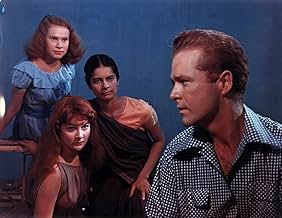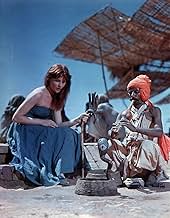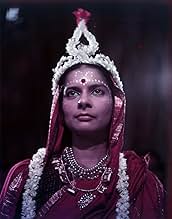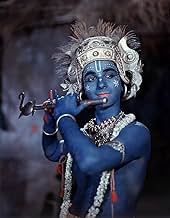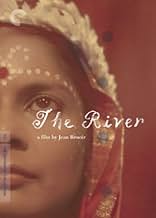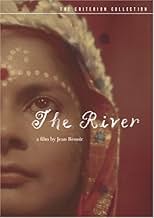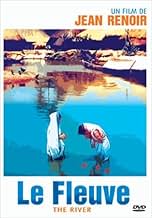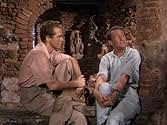VALUTAZIONE IMDb
7,4/10
7214
LA TUA VALUTAZIONE
I crescenti problemi e dolori di tre giovani donne in contrasto con l'immutabilità del sacro fiume del Bengal, attorno al quale le loro vite prendono forma.I crescenti problemi e dolori di tre giovani donne in contrasto con l'immutabilità del sacro fiume del Bengal, attorno al quale le loro vite prendono forma.I crescenti problemi e dolori di tre giovani donne in contrasto con l'immutabilità del sacro fiume del Bengal, attorno al quale le loro vite prendono forma.
- Nominato ai 2 BAFTA Award
- 3 vittorie e 4 candidature totali
June Tripp
- Narrator
- (voce)
- (as June Hillman)
Nimai Barik
- Kanu
- (non citato nei titoli originali)
Richard R. Foster
- Bogey
- (non citato nei titoli originali)
Jane Harris
- Muffie
- (non citato nei titoli originali)
Jennifer Harris
- Mouse
- (non citato nei titoli originali)
Trilak Jetley
- Anil
- (non citato nei titoli originali)
Sajjan Singh
- Ram Singh - The Gateman
- (non citato nei titoli originali)
Penelope Wilkinson
- Elizabeth
- (non citato nei titoli originali)
Cecilia Wood
- Victoria
- (non citato nei titoli originali)
Recensioni in evidenza
After a family tragedy, an adolescent girl blurts out angrily at the dinner table, "We just go on as if nothing has happened". "No", her mother responds, "we just go on". The River, Jean Renoir's first color film, is about going on -- the ebb and flow of life that mirrors the path of the sacred river Ganges that flows nearby. Filmed on location in India, The River is a sumptuously beautiful film that was called by Martin Scorsese ""one of the two most beautiful color films ever made" and one of his "most formative movie experiences." The film has been brought to life magnificently in a new Criterion DVD that contains an introduction by Jean Renoir, an interview with Scorsese, and a biography of author Rumer Godden, who grew up in India and whose work formed the basis for Powell and Pressburger's Black Narcissus (1947).
Set in India at the time of independence, its themes are universal: the feeling of being an outsider, of running away from unpleasant situations, and the hopelessly romantic stirring of adolescent love. While the film reflects the point of view of a British colonial family, it is respectful of the surrounding culture and pays homage to Hindu and Buddhist traditions through stories, documentary footage, and dance sequences. Harriet (Patricia Walters) is the adult narrator who looks back on her days as an adolescent. About thirteen in the film, she lives with her four sisters and brother Bogey in a colonial house in India that looks out upon the Ganges. Renoir's camera captures the energy and rhythm of life on the river: its peddlers, ships, markets, people coming and going, the crowds, everything in constant motion juxtaposed with the timeless tranquility of the river.
Harriet's father (Esmond Knight) who lost an eye during the war, runs a jute manufacturing plant while his pregnant wife (Nora Swinburne) takes care of the house, assisted by governess Nan (Suprova Mukerjee). When a young American named Captain John (Thomas E. Breen) comes to visit his cousin Mr. John (Arthur Shields) after losing his leg in the war, his dreams of being left alone are short lived. Harriet becomes infatuated with Captain John but has to contend with two other female admirers: her older friend Valerie (Adrienne Corri), a flaming redhead, and Mr. John's daughter Melanie (Radha Shri Ram), a young woman of mixed ethnicity who was born in India but reared in a British boarding school. The arrival of Captain John brings a clear signal that the girls must face the end of what has been an idyllic childhood.
All feel like outsiders: Melanie is caught between two cultures and questions whether she will ever fit into either, Harriet expresses her adolescent longings in idealistic poetry, Valerie is overwhelmed by her innocent desires, and Captain John is a deeply troubled man who only wants to live a normal life. Although the acting can be a bit wooden especially during peak dramatic moments, it does not detract from the film's authenticity. The River is definitely of its time and its attitudes towards women are dated, yet it is a work that transcends time and place to capture universal emotions. It is a great film that can be relished over and over again with increasing appreciation.
Set in India at the time of independence, its themes are universal: the feeling of being an outsider, of running away from unpleasant situations, and the hopelessly romantic stirring of adolescent love. While the film reflects the point of view of a British colonial family, it is respectful of the surrounding culture and pays homage to Hindu and Buddhist traditions through stories, documentary footage, and dance sequences. Harriet (Patricia Walters) is the adult narrator who looks back on her days as an adolescent. About thirteen in the film, she lives with her four sisters and brother Bogey in a colonial house in India that looks out upon the Ganges. Renoir's camera captures the energy and rhythm of life on the river: its peddlers, ships, markets, people coming and going, the crowds, everything in constant motion juxtaposed with the timeless tranquility of the river.
Harriet's father (Esmond Knight) who lost an eye during the war, runs a jute manufacturing plant while his pregnant wife (Nora Swinburne) takes care of the house, assisted by governess Nan (Suprova Mukerjee). When a young American named Captain John (Thomas E. Breen) comes to visit his cousin Mr. John (Arthur Shields) after losing his leg in the war, his dreams of being left alone are short lived. Harriet becomes infatuated with Captain John but has to contend with two other female admirers: her older friend Valerie (Adrienne Corri), a flaming redhead, and Mr. John's daughter Melanie (Radha Shri Ram), a young woman of mixed ethnicity who was born in India but reared in a British boarding school. The arrival of Captain John brings a clear signal that the girls must face the end of what has been an idyllic childhood.
All feel like outsiders: Melanie is caught between two cultures and questions whether she will ever fit into either, Harriet expresses her adolescent longings in idealistic poetry, Valerie is overwhelmed by her innocent desires, and Captain John is a deeply troubled man who only wants to live a normal life. Although the acting can be a bit wooden especially during peak dramatic moments, it does not detract from the film's authenticity. The River is definitely of its time and its attitudes towards women are dated, yet it is a work that transcends time and place to capture universal emotions. It is a great film that can be relished over and over again with increasing appreciation.
It's difficult to argue with Gabridl's remarks about the film - and I'm sure Renoir would have pleaded guilty as charged. Of not making a civics lesson. So, if that's what you want out of art, then this is not the film for you. At all. You will learn nothing of Indian politics, the "exoticism" will drive you mad, and you'd do better to go back and re-read Said's "Orientalism," as Gabridl suggests.
Renoir went to India, and made a film from the perspective of an entranced outsider looking in, creating his own, personalized world - not India, but Renoir's world, where everything is transitory, including beauty and death, and where every sight and sound becomes that much more precious.
I am glad that we have come so far since I've been a kid, when so many ideas and prejudices carried over from the colonial era were still floating through the air, and it's true that no one except that most naive among us would make a film like THE RIVER today. But Renoir was alive in 1950, not now, and he made his film for his time, and that time attaches itself to the film, just like it does to every artwork. I doubt that even Gabridl would suggest that it was the work of a craven exploiter of the masses, and that its "faults" are not the faults of a corrupt man, but of a generous and compassionate one. It's one of the most generous films I know of.
Finally, I would add that while this is a film made by a westerner for other westerners, it was certainly inspirational to Satyajit Ray, who worked as Renoir's assistant.
Renoir went to India, and made a film from the perspective of an entranced outsider looking in, creating his own, personalized world - not India, but Renoir's world, where everything is transitory, including beauty and death, and where every sight and sound becomes that much more precious.
I am glad that we have come so far since I've been a kid, when so many ideas and prejudices carried over from the colonial era were still floating through the air, and it's true that no one except that most naive among us would make a film like THE RIVER today. But Renoir was alive in 1950, not now, and he made his film for his time, and that time attaches itself to the film, just like it does to every artwork. I doubt that even Gabridl would suggest that it was the work of a craven exploiter of the masses, and that its "faults" are not the faults of a corrupt man, but of a generous and compassionate one. It's one of the most generous films I know of.
Finally, I would add that while this is a film made by a westerner for other westerners, it was certainly inspirational to Satyajit Ray, who worked as Renoir's assistant.
10Fesch
This is one of those rare films which give you the impression after viewing it that you have truly lived and shared the lives of its characters (not just 'two people received that kiss', as they say in the film, but everyone who's watching the movie).
You became part of that river as the film progresses, it is perhaps the picture which has described the passage of time better than any other. It is life, running within its waters, that catches your soul, which melts with the river and the film and your memory...
I think it is the only movie that made me run to a bookstore to buy the book it was based on. Rumer Godden's work is beautiful indeed, but the film is far better for me.
Highly recommended!
You became part of that river as the film progresses, it is perhaps the picture which has described the passage of time better than any other. It is life, running within its waters, that catches your soul, which melts with the river and the film and your memory...
I think it is the only movie that made me run to a bookstore to buy the book it was based on. Rumer Godden's work is beautiful indeed, but the film is far better for me.
Highly recommended!
India has, through the years, fascinated many a major film-maker, including Robert Flaherty, Fritz Lang, Louis Malle, Michael Powell, Roberto Rossellini and Jean Renoir. Renoir's film, based on a novel by English novelist Rumer Godden of BLACK NARCISSUS (1947) fame, is as gorgeously shot (in ravishing Technicolor) as can be expected from a master film-maker and the son of a famous French impressionist painter; however, the narrative itself is rather disappointingly thin to support its 99-minute running time. Having said that, the coming-of-age story of two English girls living in India and loving the same young officer wounded in WWII, is appealingly performed by Nora Swinburne, Esmond Knight, Arthur Shields and Adrienne Corri. The central character, played winningly by newcomer Patricia Walters (whose only film this turned out to be) is a stand-in for Godden herself, whose considerable writing talent was not encouraged by her stern family. The film offers Renoir another chance to show his humanist side dwelling as it does on the strange (to Western eyes) social and religious customs of the Indian people; even so, when all is said and done, there is just too much local color in the film. However, as Renoir is not only one of my favorite film directors but arguably the greatest of all French film-makers, I am confident that a second viewing of THE RIVER will elevate significantly my estimation of it, as it is probably too rich an experience to savor all at one go.
Among the copious supplements on the Criterion DVD, there is a typically enthusiastic interview with Martin Scorsese (who also helped in funding the film's restoration) who waxes lyrically on the effect the film had on him as a 9 year-old film-goer; surprisingly for me, he also confesses that the appeal of Renoir's masterpiece, LA REGLE DU JEU (1939), an automatic candidate for the title of the greatest film of all time, escapes him!!
Among the copious supplements on the Criterion DVD, there is a typically enthusiastic interview with Martin Scorsese (who also helped in funding the film's restoration) who waxes lyrically on the effect the film had on him as a 9 year-old film-goer; surprisingly for me, he also confesses that the appeal of Renoir's masterpiece, LA REGLE DU JEU (1939), an automatic candidate for the title of the greatest film of all time, escapes him!!
10jasonb84
This is a little known film, but well worth watching if you're lucky enough to find it on Video or TV. The director Jean Renoir is the son of the French Impressionist Painter Pierre Auguste Renoir ( the cinematographer Claude Renoir is Jean's nephew ) and the family talent shines throughout this film, which is beautifully shot. Whether showing the amazing landscape of India and the river itself, the colours and intricacies of the many Indian festivals, or even a close up of Valerie's face as she gazes at Captain John, every frame displays grace, beauty and style that film rarely captures.
The plot itself, how a troubled outsider affects three teenaged girls, is a simple tale, and all the more powerful for it. We've all had a crush, and know the river of emotions that are awakened by one. Each of the three girls, the irrepressible and dramatic Valerie, the talented but awkward Harriet, and the stoic Melanie ( who despite schooling in the West is somehow more Indian in nature than her friends who've been brought up in India ) vie for Captain John's affections in their own way.
However, the real love of this film is India itself - it's fascinating people, beliefs, festivals, and the constant River that runs through them all. It's a slow paced film, not in a hurry to get to any kind of conclusion, and you are immersed in the country, and what it's like to live there. Like relaxing on one of the many river boats, as its floats gently downstream, the film meanders along, showing us different scenes along the way, from the local postman's route to the house gates to the son's fascination with Cobras, with the story always moving on, though always interwoven with more day to day life. This brings a familiar reality to the film, it doesn't just skip moments that might not immediately concern the main characters - like life, other events happen, and they have their place in this film too.
Actually getting to watch this film will be hard, it's not well known ( and not even considered one of Renoir's best ), but if you ever come home one night, flick on the TV, and see this starting, then get comfortable, and enjoy a lovingly made film about a country and the people, both native and foreigners, who live there.
The plot itself, how a troubled outsider affects three teenaged girls, is a simple tale, and all the more powerful for it. We've all had a crush, and know the river of emotions that are awakened by one. Each of the three girls, the irrepressible and dramatic Valerie, the talented but awkward Harriet, and the stoic Melanie ( who despite schooling in the West is somehow more Indian in nature than her friends who've been brought up in India ) vie for Captain John's affections in their own way.
However, the real love of this film is India itself - it's fascinating people, beliefs, festivals, and the constant River that runs through them all. It's a slow paced film, not in a hurry to get to any kind of conclusion, and you are immersed in the country, and what it's like to live there. Like relaxing on one of the many river boats, as its floats gently downstream, the film meanders along, showing us different scenes along the way, from the local postman's route to the house gates to the son's fascination with Cobras, with the story always moving on, though always interwoven with more day to day life. This brings a familiar reality to the film, it doesn't just skip moments that might not immediately concern the main characters - like life, other events happen, and they have their place in this film too.
Actually getting to watch this film will be hard, it's not well known ( and not even considered one of Renoir's best ), but if you ever come home one night, flick on the TV, and see this starting, then get comfortable, and enjoy a lovingly made film about a country and the people, both native and foreigners, who live there.
Lo sapevi?
- QuizThomas E. Breen, who plays Capt. John, was really missing one leg like his character.
- Blooper(at around 36 mins) A cigarette appears from nowhere.
- ConnessioniFeatured in Lontano (2001)
I più visti
Accedi per valutare e creare un elenco di titoli salvati per ottenere consigli personalizzati
- How long is The River?Powered by Alexa
Dettagli
- Data di uscita
- Paesi di origine
- Sito ufficiale
- Lingue
- Celebre anche come
- Río sagrado
- Luoghi delle riprese
- Azienda produttrice
- Vedi altri crediti dell’azienda su IMDbPro
Botteghino
- Lordo in tutto il mondo
- 53.357 USD
- Tempo di esecuzione1 ora 39 minuti
- Proporzioni
- 1.37 : 1
Contribuisci a questa pagina
Suggerisci una modifica o aggiungi i contenuti mancanti


